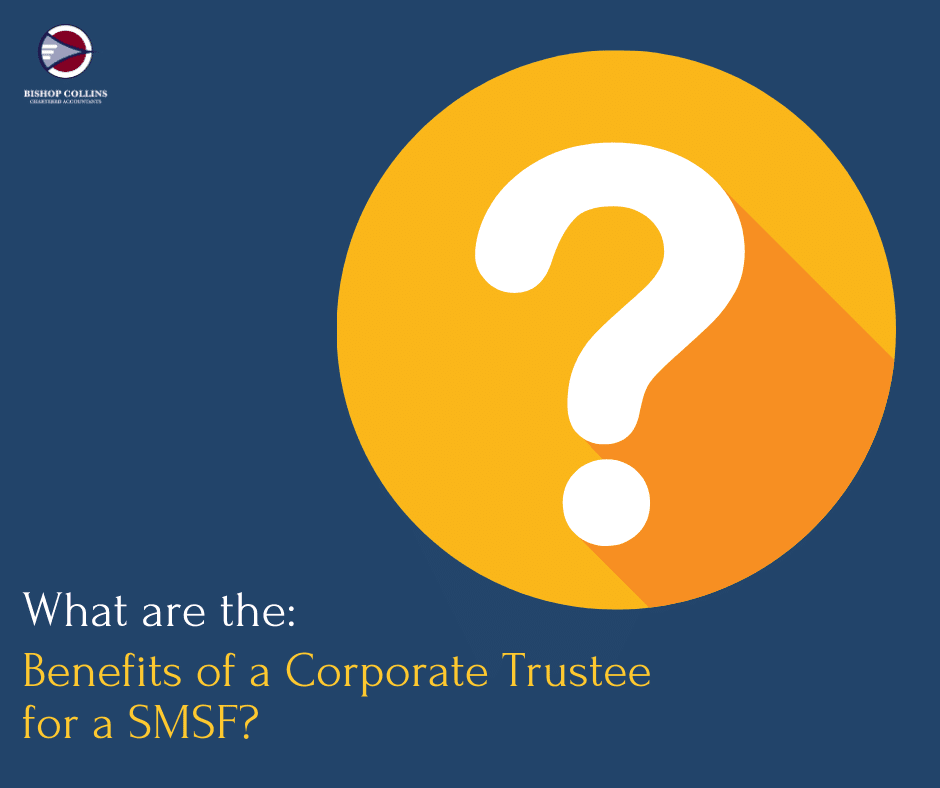
Phillip Keenan
Company Director
If the trustee of a self-managed super fund (SMSF) is a company, it is known as a corporate trustee.
Despite the overall benefits of having a corporate trustee, the ATO have revealed statistics showing the majority of SMSF’s have individual trustees – (SMSF: 8 reasons a corporate trustee is better (afr.com)).
These are alarming statistics. Outlined below are 5 important reasons demonstrating the benefit of a corporate trustee over an individual trustee for your SMSF.
Reason 1 – Reduced Administration: Administratively simpler if a members change in the SMSF
A company is a separate legal entity which continues to exist if there are changes to the members of a SMSF (due to death or otherwise).
A SMSF with a corporate trustee and two or more members will generally continue to satisfy the definition of a SMSF if:
- Each member of the SMSF is a director of the trustee; and
- No member is an employee of another member unless the members are relatives.
In this instance, if a member is added or leaves the SMSF then they either need to be added or removed as a director of the corporate trustee. This is done by lodging the relevant documentation with the Australian Securities and Investments Commission (ASIC). No other changes are required.
In contrast, if a member is added to or leaves a SMSF with individual trustees, the SMSF is required to notify all relevant registries and offices. They also need to provide the associated documentation to support the change in legal ownership (as all assets in a SMSF are legally owned by the trustee(s) on behalf of or in trust for the members of the SMSF). This process can be difficult and time-consuming depending on the number of assets which the SMSF owns.
The existing trustees may also need to seek legal advice to ensure they’re compliant with the terms of the deed relating to the appointment/removal of the trustee. This imposes additional costs on the SMSF.
Reason 2 – Asset Seperation: Easier to separate the assets of the SMSF from the assets of the member
Regulations require the trustee of a SMSF to keep their personally owned assets separate from the assets of the SMSF.
Some instances of non-compliance can arise where:
- A SMSF operates using a member’s bank account rather than a SMSF bank account,
- Or where the member inadvertently records the ownership of an asset personally as opposed to in their capacity as trustee.
The penalties for non-compliance can be significant (refer below).
Appointing a corporate trustee for your SMSF means that you’re less likely to breach this Regulation.
Reason 3 – Retain Control: A corporate trustee can be the trustee of a SMSF with a single member
A SMSF with a corporate trustee and a single member will generally continue to satisfy the definition of a SMSF if:
- The member is the sole director of the company.
- One of only two directors and the other director is a relative of the member: or
- One of only two directors and the member is not an employee of the other director.
A SMSF with an individual trustee and a single member will generally continue to satisfy the definition of a SMSF if:
- The member is one of only two trustees, one of whom is the member and the other is a relative of the member: or
- The member is one of only two trustees and the member is not an employee of the other trustee.
An individual can only completely control the decision making in their capacity as the trustee of the SMSF if they have a corporate trustee.
If a member elects to have an individual trustee they will need to share the decision making and control of the SMSF with either a relative or another person of legal age. This is likely to be counter-intuitive, as control is likely to be one of the reasons why the SMSF was established in the first place.
Reason 4: Lower ATO administrative penalties
The trustee of a SMSF is required to abide by certain rules. If they fail to abide by these rules, the Commissioner has the power to issue a penalty notice to the trustee. The penalty will be equal to the number of penalty units associated with the breach, multiplied by the current value of the penalty unit (which is currently $222). The penalty is payable by the trustee and can’t be paid from the assets of the SMSF.
Interestingly, for an SMSF with individual trustees, the penalty will be levied against each trustee individually. In contrast, for an SMSF with a corporate trustee, the penalty will only be levied against the company as opposed to each director of the corporate trustee. This means that the trustees of a SMSF with four members and individual trustees would pay a fine which is four times the value of a SMSF with four members and a corporate trustee.
Reason 5 – Protection for Individuals: Better protection for individual fund members if the SMSF is subject to litigation
Individual trustees are jointly liable for all liabilities of the SMSF. If the SMSF incurs a liability which is greater than its assets, then the personal assets of the individual trustees may be at risk.
The possibility of this situation arising may be more common than you think. For example, it can arise in situations where a non-complying fund is issued with a notice of assessment equal to 45% of the market value of its assets (less any contributions that aren’t included in the SMSF’s taxable income) in the year of non-compliance, followed by a significant devaluation of the assets of the SMSF. There will be insufficient funds to settle the liability even after the assets of the SMSF are liquidated.
This situation can be avoided by having a corporate trustee. Companies have limited liability, meaning liability is limited to the value of the assets of the SMSF and the director’s personal assets will not generally be at risk.
These are the key benefits of setting up a SMSF with a corporate trustee. These benefits need to be traded off against the initial cost of setting up the corporate trustee and the annual fee payable to ASIC. In most instances, you’ll find the benefits of a corporate trustee will far outweigh the initial and ongoing costs.
Setting up a SMSF is a great way to plan for your retirement. It is important to understand these differences between an individual trustee and a corporate trustee upon establishment of your SMSF.



